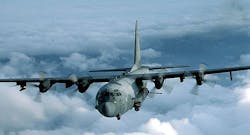Navy approaches industry for ideas on electro-optical sensor suite for special forces attack planes
Officials of the Naval Surface Warfare Center (NSWC) division in Crane, Ind., issued a source-sought notice this week (N0016415SNB28) for the Long Range Multi-Sensor EO/IR Stabilized Gimbal with Multi-Function Laser Designator/Rangefinder/Illuminator, High-Definition Full-Motion Infrared and Visible Video and High-Accuracy Target Location Systems project.
Navy experts are surveying industry to see which companies could build such an electro-optical airborne sensor system for special operations version of the C-130 aircraft. The sensor suite should have a ball diameter no larger than 30 inches, and weigh no more than 300 pounds.
The multi-sensor gimbaled system must be compatible with the C-130J aircraft and its operating environment, as well as with existing and modified hardware mounting and data interfaces.
The sensor package also should be able to handle fire-control for the U.S. Special Operations Command precision-strike package for the AC-130 gunship, which consists of sensors, a 30-millimeter gun, standoff precision-guided munitions, a mission operator console, a communications suite, and flight deck hardware.
Related: L-3 to develop imaging radar prototype to give AC-130 gunship more punch in bad weather
Specifically the sensor should have high data rate communications, video, data, command and control, interlocks, and safety systems to work adequately with the Precision Strike Package.
The sensor system must have simultaneous output of four or more cameras including color daylight, long-wave, mid-wave, and short-wave infrared, and low-light cameras. Each camera must have multiple fields of view (FOV) to enable airborne surveillance and targeting.
The camera systems must be able to detect and decode tactical overt and covert marking devices. Navy officials are asking for continuously variable fields of view, as well as visibility and illumination through haze and other reduced-visibility conditions.
Also necessary is high-definition video capability, with commercial-standard high-definition (HD) camera outputs of at least 1,080 pixels and standard-definition (SD) formats.
Related: Northrop Grumman joins L-3 in DARPA program to help AC-130s attack targets in bad weather
The sensor system also must be able to perform manual and automatic high-accuracy target locating and tracking, as well as line-of-sight pointing data for weapons delivery. The system must be capable of geo-location and providing sensor generating data to other aircraft.
Finally, the sensor system must multi-spectral/multi-band/multi-function lasers, including weapon designators and illuminators/markers for multi-spectral pointing in visible light and infrared bands, as well as laser rangefinding and laser designating. Covert area illumination also is a requirement.
Companies interested should email white papers no later than 18 March 2015 to the Navy's Brian Tussey at [email protected], with a copy to Vonda Pollock at [email protected].
For questions or concerns contract Brian Tussey by phone at 812-854-5174, or by email at [email protected]. More information is online at https://www.fbo.gov/spg/DON/NAVSEA/N00164/N0016415SNB28/listing.html.
